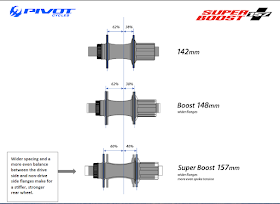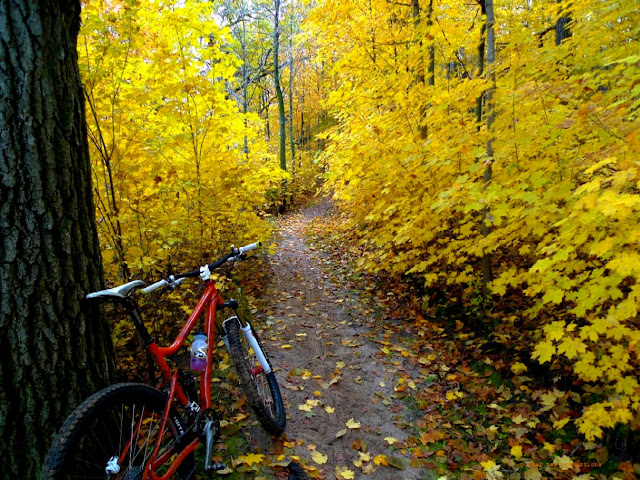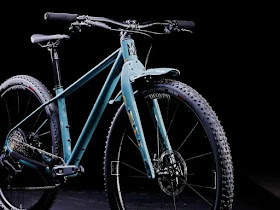Note: State Bicycle Co sent over their Monster Fork v2 for test and
review at Guitar Ted Productions at no cost. Guitar Ted is not being
bribed, nor paid,for this review and all opinions are his own. The State Bicycle Co. Monster Fork v2 has been ridden, had its offset changed, been measured, and had a bit of a rough spell there for a bit. In this post I will explain all of that. The introductions and first impressions of this fork can be found by clicking HERE.
The Ride Quality:
So, first up we have the ride performance of this fork. Some of my regular blog readers already have read about a bit of my first gravel ride on this fork HERE, but for those coming from elsewhere on the innergoogles, I will give a brief recap.
On the way out of town I misread a curb, thinking it was at street level when in reality it was several inches high. I ran straight into it at somewhere between 5mph and 10mph. When I hit the curb, I felt the tire bottom out on the rim and heard a big "crack" sound. Thinking I damaged the rim, I tried to find where the rim may have failed but I could find nothing. I checked again after several miles and then noted the brake was rubbing the rotor. Odd, but - The Monster Fork has those aluminum inserts to switch the offset, right? So what if one or both made a position change when I hit that curb and moved the axle just enough to cause brake rub? A bit of brake massaging caused the rub to go away, so I am pretty sure the loud cracking noise was just the aluminum chip/plates moving slightly in their pockets due to my gaff on the curb read.

The ride quality is what I would call "normal". What I mean to say is that the new Monster Fork rode pretty much like my old Noble fork which came with the bike. Makes sense since all the geometry is pretty similar in the Monster Fork's shorter offset setting.
No weird steering issues either. In fact, the fork felt great on the gravel considering the stability and steering inputs were again, very similar to what I expect out of this bike.
This is all very good and with the Monster Fork v2, I have options to carry luggage or extra bottles, something I could not do with the original fork.
The Challenges:
After the successful test rides it was time to take out the offset chips and flip them for the change in offset. The first check came when the front wheel would not come out easily. I ended up tapping the tire with a dead blow hammer to get the wheel out. Hmm.... A tolerance issue with Industry 9 hubs, perchance, or....? I would have to investigate this further, but I was eager to do some measuring, so I moved on to flipping the chips and then the next check showed up.
Flipping the chips is only one part of changing the offset on this fork. You must also flip the brake mount 180° as well. I did not catch this detail. It isn't an obvious step in the process. There is no guidance on State's website, and I did not receive any paperwork when the fork was shipped to me. Perhaps customers get an instructional sheet?
After a bit of downtime and communication with my contact for State, this was cleared up for me. I had also mentioned the tolerance issue with the Industry 9 hub, and the response was "We haven't heard about any issues like this before". I ended up trying a HED Eroica wheel and it went in and back out just fine. The Industry 9 hub also was going in easier after the flip of everything, but still wasn't perfect. I think this can be attributed to a slightly imperfect fit between the chip and the carbon fork pocket it is supposed to fit into. There also may be a slight tolerance issue with some other hub brands, but I think this may be an isolated issue. At any rate, it is something to note.
Crunching The Numbers:
Remembering what I wrote to you in the first impressions post, you might recall that the overall wheel diameter, fork offset/rake, and the head tube angle can be put into a formula to give you fork trail. That measure helps to determine how stable, or unstable, a bike might be.
The marketing from State gets this wrong, but what is true is that more offset equals less fork trail. This, in practice, makes a bicycle less stable. So, in the case of this Monster Fork v2, we have a choice for a shorter offset and one for a longer offset. The choices are 49mm and 55.5mm. The fork came in the 49mm offset setting.
Following are the numbers I measured with a tape measure and an angle gauge on my iPhone. These numbers were plugged into an online fork trail calculator. The head angle, wheel diameter, and fork offset affect other geometry numbers as well, which are also accounted for in the following results. Note: The wheel diameter remains constant throughout. Changing wheel diameter (different tire) would add another variable. The head angle, you will note, is slacker in the longer offset setting. That is because the axle to crown, (length of the fork, basically) is longer in the longer offset setting.
49mm Offset/Rake: Head tube angle: 71°, Wheel Diameter 712mm - Fork Trail = 58.42mm Other numbers: Seat tube angle: 72°, Bottom Bracket Height: 11 3/8ths"/289mm
55.5mm Offset/Rake: Head tube angle: 69.5°, Wheel Diameter 712mm - Fork Trail = 73.66mm. Other Numbers: Seat Tube Angle 71.5°, Bottom Bracket Height: 11 7/16ths"/291mm. Saddle Angle tipped up by 1°
What Does It Mean? The difference in fork trail is 15.24mm. (.6 inch) That's nearly indistinguishable in real terms. Where you would see a definitive difference in handling traits is by increasing or decreasing the wheel diameter. Of course, you can do this by using 650B wheels or 700c wheels, but you also can do this with the Monster Fork v2 by using smaller or larger volume tires. That's really the feature worth focusing on with the Monster Fork V2. Moving to the longer offset would allow me to use a true 29" wheel/tire combination, albeit on the smaller side of the scale for 29"ers. Only then would you increase the trail figure by enough that it would be noticeable.
Updated: Note that the slacker head angle due to a longer axle to crown affects the trail figure here the most. Again, larger diameter tires will do a similar thing. Basically, the larger the differential between rear wheel diameter and front wheel diameter, with the front always larger, will increase trail figures as the wheel gets larger up front. On my bike I cannot install a larger rear tire than a 45mm, so in my case, if I wanted more snappy handling, I would keep the tire sizes the same in the longer offset setting.
Note the changes to head tube, seat tube, and saddle angles. These things, along with bottom bracket height, might actually be more noticeable to a rider. Especially regarding fit. Keep this in mind if you switch offsets on this fork, or if you change forks that have different axle to crown heights, which can have similar affects on geometry.
In the end, maybe none of the above matters! Look around and you can easily find people riding bicycles with incorrectly installed forks from department stores. These backward forks result in negative trail and people still ride them with "no big deal" involved. How can this be? Well, Humans are very adaptable creatures, that's why. These minute changes resulting from swapping a flip chip on the Monster Fork v2 are likely going to be easily adapted to by most anyone and probably wouldn't be noticed by most riders. So the tire clearance is really the big deal here.
So Far... That's enough for this update! Next I plan on riding the Monster Fork v2 in the longer offset setting, putting a load on the fork using the accessory mounting bolts along each fork leg, and I will also be trying out a fatter front tire to see what that looks like.
Up to this point I can say that my only real concern is how those chips set into the fork and how that has affected getting my I-9 wheel in and out of this fork. As it stands right now the I-9 wheel does install much easier than before, so that's good to see, but if this fork is representative of what to expect from this product there might be some hubs that are not really good matches for the Monster Fork v2 and some that are and nobody really knows for certain right now.
Otherwise the ride quality is right on par with most carbon gravel forks. The handling in the short offset setting was spot-on and I don't anticipate that the longer offset setting will be an issue, or maybe even noticeable. Stay tuned for the final word on this fork soon.












































